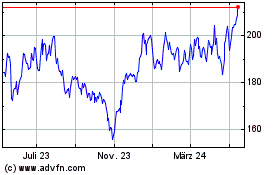By Don Clark
Slowing growth and rising costs are driving a historic wave of
consolidation among semiconductor makers looking to streamline
their organizations and product lines.
So far this year, chip companies have announced $100.6 billion
in mergers and acquisitions, according Dealogic, exceeding the
$37.7 billion total for all of 2014.
There have been fewer deals--276 announced so far this year,
compared with 369 in 2014, Dealogic says. But the deals are larger,
including Avago Technologies Ltd.'s sector-record $37 billion
purchase of Broadcom Corp., announced in May.
The totals could go higher. Bloomberg reported last week that
four chip companies-- Analog Devices Inc., Maxim Integrated
Products Inc., SanDisk Corp. and Fairchild Semiconductor
International Inc.--were in talks concerning different deal
options. Representatives of those companies declined to
comment.
"It's buy or be sold," summed up Alex Lidow, chief executive of
Efficient Power Conversion Corp., a startup he co-founded in 2007
after 30 years leading chip maker International Rectifier Corp.
Chip makers have long used acquisitions to obtain new
technology. But many recent deals resemble consolidation waves in
older industries, motivated mainly by trimming costs in areas like
manufacturing, sales and engineering.
Avago, for example, has projected it can wring $750 million in
annual savings beginning in 2017 after swallowing Broadcom. That
transaction was the largest high-tech acquisition on record before
Dell Inc. announced its $67 billion plan to buy EMC Corp. last
week.
In part, chip makers are responding to intense competition that
is crimping revenue. Chips are as important as ever, and now appear
in a broader range of everyday products, including cars, appliances
and other gadgets in homes and businesses.
But Gartner Inc. this month projected that world-wide
semiconductor revenue would decline 0.8% this year, the first dip
since 2012. The research firm predicts sales will grow 1.9% in
2016, to $344.1 billion.
Reducing the number of suppliers can ease price competition, and
help the survivors combine complementary product lines, industry
executives say. That saves money on sales efforts while allowing
companies to sell a great number of chips that in some cases can be
tailored to work better together. For example, Intel Corp. says its
planned $16.7 billion acquisition of Altera Corp. will let it craft
new products to improve hardware like server systems.
"Customers more and more want to have fewer suppliers and more
value, and pieces that work together," said Jalal Bagherli, chief
executive of U.K.-based Dialog Semiconductor PLC, after announcing
a $4.6 billion acquisition of its deal for Atmel Corp. last
month.
At the same time, the cost of designing new chips continues to
escalate, as Moore's Law allows chip makers to squeeze more
circuitry on each square of silicon. Designing a chip with more
transistors takes longer and costs tens of millions of dollars more
than earlier technology.
Companies like Intel that sell huge volumes of particular
products can take those costs in stride. But others developing
products for smaller markets can't expect to generate enough
revenue to cover development costs. New entrants from China and
Taiwan add to pricing pressure.
"We now have a combination of slowing growth in a mature market,
along with an increase in the cost and the complexity of being in
the semiconductor industry," said Mark Edelstone, a managing
director at Morgan Stanley, which advises chip makers on mergers
and acquisitions. "That combination is challenging."
Some chip makers that specialize in older analog
technologies--used for chores like converting voltages and
measuring temperatures--have suffered less from competition. But
they have begun feeling pressures from slowing growth, too.
One example is Mr. Lidow's former company, founded in 1947 by
his father and grandfather. International Rectifer in January was
acquired by Germany's Infineon Technologies AG for about $3
billion, a deal whose stated motivations included melding two lines
of power-management chips. Mr. Lidow, shying away from the battle
to build a new business in silicon chips, opted after leaving
International Rectifier in 2007 to start a company focusing on
gallium nitride, an alternative material that is being used instead
of silicon for applications like managing power in electronic
devices.
As the chip industry matures, the age of some leaders is also a
factor. One example is Raymond Zinn, 78 years old, who led Silicon
Valley chip maker Micrel Corp. for 37 years. The company agreed to
an $839 million buyout from Microchip Technology Inc. that closed
in July.
"You have CEOs who are getting older," said Dan Niles, a
longtime industry watcher and founding partner at investment
management firm Alpha One Capital Partners. "To some extent it's
the changing of the guard."
Write to Don Clark at don.clark@wsj.com
Access Investor Kit for "FAIRCHILD SEMICONDUCTOR INTERNATIONAL
INC"
Visit
http://www.companyspotlight.com/partner?cp_code=P479&isin=US3037261035
Subscribe to WSJ: http://online.wsj.com?mod=djnwires
(END) Dow Jones Newswires
October 18, 2015 16:59 ET (20:59 GMT)
Copyright (c) 2015 Dow Jones & Company, Inc.
Analog Devices (NASDAQ:ADI)
Historical Stock Chart
Von Jun 2024 bis Jul 2024

Analog Devices (NASDAQ:ADI)
Historical Stock Chart
Von Jul 2023 bis Jul 2024
